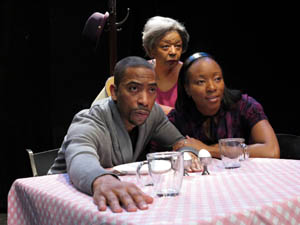 |
|||||
|
| EASTER
This suspenseful masterpiece, originally set in a Swedish coastal town in 1901, was adapted to Harlem in 1958 by director Robert Greer. "Easter" is a strange mingling of symbolism and realism, bearing a spiritual message of resurrection. It examines themes of suffering and transcendence through forgiveness, as seen in the Hest family, which is shamed and tortured by a family disgrace. The father has been imprisoned for mismanaging orphans' estates. The daughter, Leonora, has been committed to an asylum, but has fled it to rejoin her family. In a foolish mistake, she has "bought" a flower from a closed shop and fears being exposed for it, which could lead to prison or being returned to the asylum. A major creditor of the family has moved next door and the family trembles at his every approach. Mrs. Hest and her son, Ellis, know that they are on the brink of ruin. Ellis is particularly burdened by the dark cold of winter and his depressing guilt over his father's sanctions. But as the snow melts and a single daffodil appears, Easter Eve brings them hope, joy and mercy. The play passes from impending doom to a rejoicing at deliverance with a power which can barely be matched in theater of its time. Not everything Strindberg wrote was autobiographical, but with his characteristic "subjectivity," he continually reinterpreted events which had happened to him. "Easter" follows that pattern. Strindberg's own father had gone bankrupt, was widowed and then married the serving girl in the house. August carried the guilt of his father's financial and social falls throughout his life. It is interesting to note that bankruptcy, in Lutheran Sweden, was considered a sin. (In fact, the works for "sin" and "debt" have a common Swedish root.) "At least 55 of his plays have to do with guilt," muses Robert Greer, Artistic Director of August Strindberg Rep, adding, "Today there are lots of white collar criminals whose kids would feel similar to the son in this play." To emphasize the timelessness of its themes, the play was adapted from a Swedish coastal town in 1901 to Harlem in 1958. The cast was allowed to colloquialize their parts, to relax the diction. Greer theorized that in this "modern" setting, having Dad in jail for squandering black orphans' inheritances would have been a stigma that everyone can relate to. Also, the politics of the two eras are surprisingly analogous. At the historical time of the play, labor strife in Sweden was intensifying, bringing the socialists to power for the first time. Strindberg's Ellis would have been a social democrat while the Governor would have been a rightist. Ellis has to be blackmailed by the family's creditor to write a letter of thanks to the Governor. This fits with the "modern" black cast concept since Ellis, living in 50's New York, might have been a Harlem radical while the establishment party was white. "Easter" can be seen as a prequel to "Playing with Fire." "Easter" debuted in 1901 and "Playing with Fire" dates from 1892, putting them on opposite sides of Strindberg's psychotic attacks of 1894-96 (which he called his "inferno crisis"). "Playing with Fire" is a comedy and "Easter" is one of his later realistic plays. However, they fit together like two pieces in a jigsaw puzzle. They both focus on a son--a painter in "Playing with Fire" and a teacher in "Easter"-- whose fate is dominated by a disgraced father and an untrustworthy, unpredictable best friend. The father, who was imprisoned for embezzlement in "Easter," has restored himself to wealth in "Playing with Fire." The son's wife nearly goes off with her husband's best friend in "Playing with Fire" and in "Easter," an untrusted friend steals from the son's academic work but intervenes on behalf of the son's family with the Governor. According to Robert Greer, the plays depict the same family, leading to his unifying adaptation. "Easter" was the most popular play of the chamber plays produced at the Intimate Theatre in Stockholm during Strindberg's later career, where it was given over two hundred times. The character of Leonora, the daughter who was driven mad by shame over her father, is one of Strindberg's best female roles and is based on his sister Elisabeth, who was institutionalized. Nathan James,
who played the son in "Playing With Fire," took the
role of the guilt-ridden Ellis in "Easter." Since the
father is unseen in "Easter," Jolie Garrett, who played
the father in "Playing With Fire," played the family’s
creditor in "Easter." The cast also featured Ley Smith
(as the daughter, Leonora), Carol Carter (as the Mother), Chudney
Sykes (as Ellis' fiancee) and DeSean Stokes (as Benjamin, an orphan
whose inheritance the family patriarch stole and who now lives
with the family). The play was designed by Angelina Margolis with
lighting by Miriam Crowe, who were the design team of "Playing
With Fire."
an admirable
undertaking … These actors make you feel proud of small
troupes dedicated to obscure plays.--Ken Jaworowski, New
York Times
|





